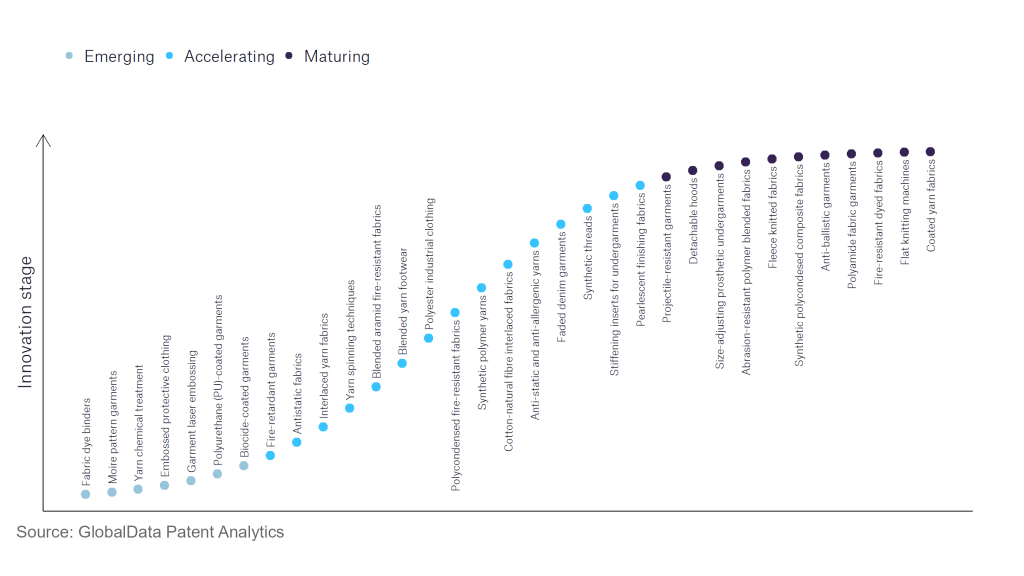The apparel industry continues to be a hotbed of innovation, with activity driven by comfort, advanced materials, and technology, and the growing importance of technologies such as synthetic polymer yarns, blended fabrics, and anti-static fabrics. In the last three years alone, there have been over 32,000 patents filed and granted in the apparel industry, according to GlobalData’s report on Innovation in Apparel: Anti-static fabrics. Buy the report here.
However, not all innovations are equal and nor do they follow a constant upward trend. Instead, their evolution takes the form of an S-shaped curve that reflects their typical lifecycle from early emergence to accelerating adoption, before finally stabilising and reaching maturity.
Identifying where a particular innovation is on this journey, especially those that are in the emerging and accelerating stages, is essential for understanding their current level of adoption and the likely future trajectory and impact they will have.
20+ innovations will shape the apparel industry
According to GlobalData’s Technology Foresights, which plots the S-curve for the apparel industry using innovation intensity models built on over 13,000 patents, there are 20+ innovation areas that will shape the future of the industry.
Within the emerging innovation stage, yarn chemical treatment, embossed protective clothing, and garment laser embossing are disruptive technologies that are in the early stages of application and should be tracked closely. Fire retardant garments, antistatic fabrics, and interlaced yarn fabrics are some of the accelerating innovation areas, where adoption has been steadily increasing. Among maturing innovation areas are flat knitting machines and coated yarn fabrics, which are now well established in the industry.
Innovation S-curve for the apparel industry

Anti-static fabric is a key innovation area in apparel
An anti-static yarn consists of conductive filaments and fibres. Anti-static garments can be anything including t-shirts, shirts, jumpers, facemasks, gloves, hair nets, shoes, high-visibility jackets, and lab coats. Anti-static yarns are blended with other yarns to create a garment that resembles any other textile, with anti-static properties.
GlobalData’s analysis also uncovers the companies at the forefront of each innovation area and assesses the potential reach and impact of their patenting activity across different applications and geographies. According to GlobalData, there are 10+ companies, spanning technology vendors, established apparel companies, and up-and-coming start-ups engaged in the development and application of anti-static fabrics.
Key players in anti-static fabrics – a disruptive innovation in the apparel industry
‘Application diversity’ measures the number of different applications identified for each relevant patent and broadly splits companies into either ‘niche’ or ‘diversified’ innovators.
‘Geographic reach’ refers to the number of different countries each relevant patent is registered in and reflects the breadth of geographic application intended, ranging from ‘global’ to ‘local’.
Patent volumes related to anti-static fabrics
| Company | Total patents (2021 - 2023) | Premium intelligence on the world's largest companies |
| Teijin | 72 | Unlock Company Profile |
| DuPont de Nemours | 25 | Unlock Company Profile |
| Welspun Group | 23 | Unlock Company Profile |
| Toray Industries | 18 | Unlock Company Profile |
| Albany International | 12 | Unlock Company Profile |
| National Safety Apparel | 11 | Unlock Company Profile |
| CEA | 10 | Unlock Company Profile |
| NIKE | 9 | Unlock Company Profile |
| Mitsubishi Gas Chemical | 8 | Unlock Company Profile |
| B&C Private Foundation | 8 | Unlock Company Profile |
| Sensomedical Labs | 7 | Unlock Company Profile |
| Mizuno | 6 | Unlock Company Profile |
| Hyosung | 6 | Unlock Company Profile |
| Politechnika Lodzka | 6 | Unlock Company Profile |
| Coolcore | 6 | Unlock Company Profile |
| Compass Diversified Holdings | 5 | Unlock Company Profile |
| Seiren | 5 | Unlock Company Profile |
| Intel | 5 | Unlock Company Profile |
Source: GlobalData Patent Analytics
The leading player in the anti-static fabric space in terms of patents filed is Teijin, followed by DuPont de Nemours, Welspun Group, Toray Industries, and Albany International. Teijin offers different fibres with anti-static properties. Rapia, a polyester fibre, offers anti-static properties that are long-lasting even after repeated washing. Microft, made with microfibers, is a high-density fabric. A type of Microft fabric offered by Teijin comes with anti-static properties.
In terms of application diversity, Intel leads, followed by CEA, Hyosung, and Nike.
The leading players in this space in terms of geographic reach are Albany International, B&C Private Foundation, Politechnika Lodzka, and Mizuno.
Anti-static fabrics will pick up momentum in the future as static electricity carries risks of electronic failure, and fires and explosions.
To further understand the key themes and technologies disrupting the apparel industry, access GlobalData’s latest thematic research report on Apparel.
Data Insights
From

The gold standard of business intelligence.
Blending expert knowledge with cutting-edge technology, GlobalData’s unrivalled proprietary data will enable you to decode what’s happening in your market. You can make better informed decisions and gain a future-proof advantage over your competitors.



